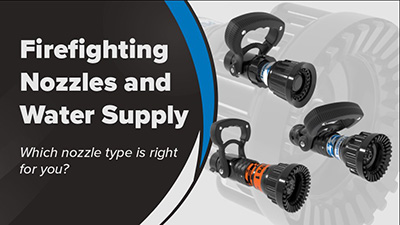How Does Water Supply Affect Your Firefighting Nozzle Choice?
Getting water to the fire in the fastest way possible is arguably one of the most important tactics on the fire ground aside from preservation of life. That’s why the fire service is so passionate about their nozzle selection. Your nozzle is the first line of defense in saving lives and protecting property for the majority of fires that occur.
Nozzle selection varies widely across the globe and factors affecting that choice include tradition, hazards within the response area, attack hose kink resistance, attack hose diameter, length of an average hose stretch, flow and move tactics, pulsing tactics, target flow rate and the often-forgotten water supply.
Does Everyone Need to Consider Water Supply?
Water supply is an important piece of the puzzle when choosing the right nozzle type for your department, but different departments face different challenges. As you dive into nozzle selection, consider how your department typically gets their water.
Urban Firefighting Water Supply

If considering water supply has not come up during the process of deciding on a nozzle for your department, it could be that it isn’t something you typically worry about. If you serve a major city, you probably have a hydrant connection every 300 feet at minimum. If these hydrants are well fed, you likely don’t worry about how much water you have on hand, so thinking through water supply during a nozzle evaluation won’t connect with your everyday reality.
However, if you serve an urban environment with poor water supply, or a district that has both urban and rural considerations, the question may be more relevant to you.
Rural Firefighting Water Supply

If your department doesn’t have a hydrant within a fifty-mile radius, water supply is a significant factor in your nozzle choice.
When you are fighting a fire in a rural area and your portable drop tank is low, but you still want to get your available water to the seat of the fire, your initial attack nozzle selection becomes extremely important. If it wasn’t selected with water supply challenges in mind, you may not be able to accomplish your goal.
Likewise, if pressure and flow rates from the supply side vary widely in your response district, you may lean toward selectable and/or automatic nozzles rather than fixed flow options.
Firefighting Nozzles and Water Supply
Fixed Flow Nozzles and Water Supply
Selectable Nozzles and Water Supply
Automatic Nozzles and Water Supply
Conclusion
No matter your water supply challenges, selectable and automatic nozzles have the ability to adjust to the available supply while resulting in a consistent, hard-hitting stream that reaches your intended target. Fixed flow nozzles offer less flexibility but can work well for departments with access to a stable and reliable water supply.
Getting the right tool for the job is essential, and we want to be sure you are as informed as possible. Be sure to contact us for any questions you have about nozzle selection.
Do you have a nozzle type in mind? Explore our handline firefighting nozzles here.



